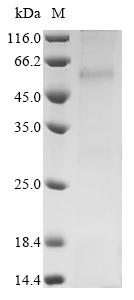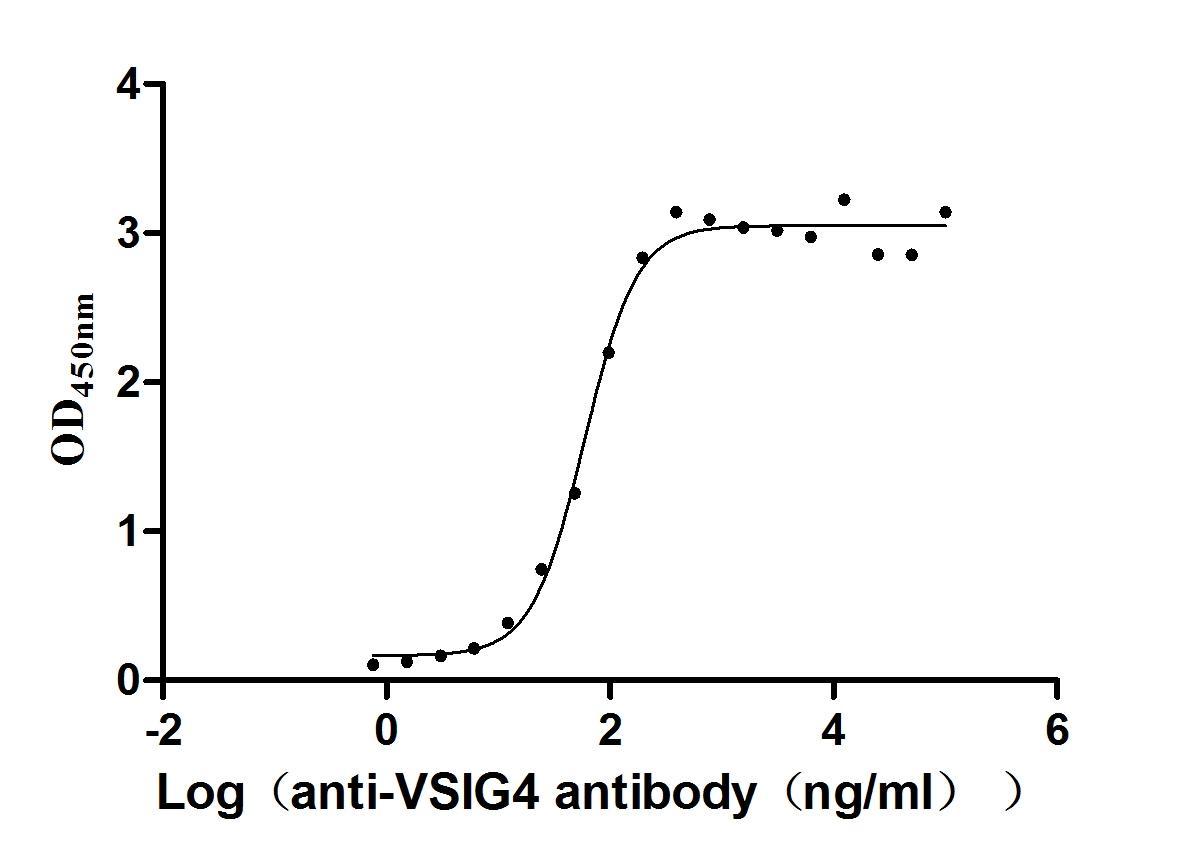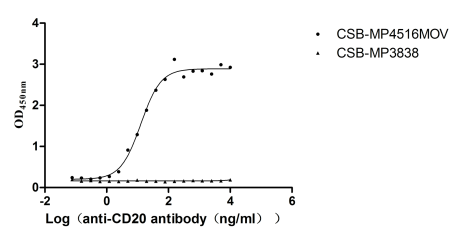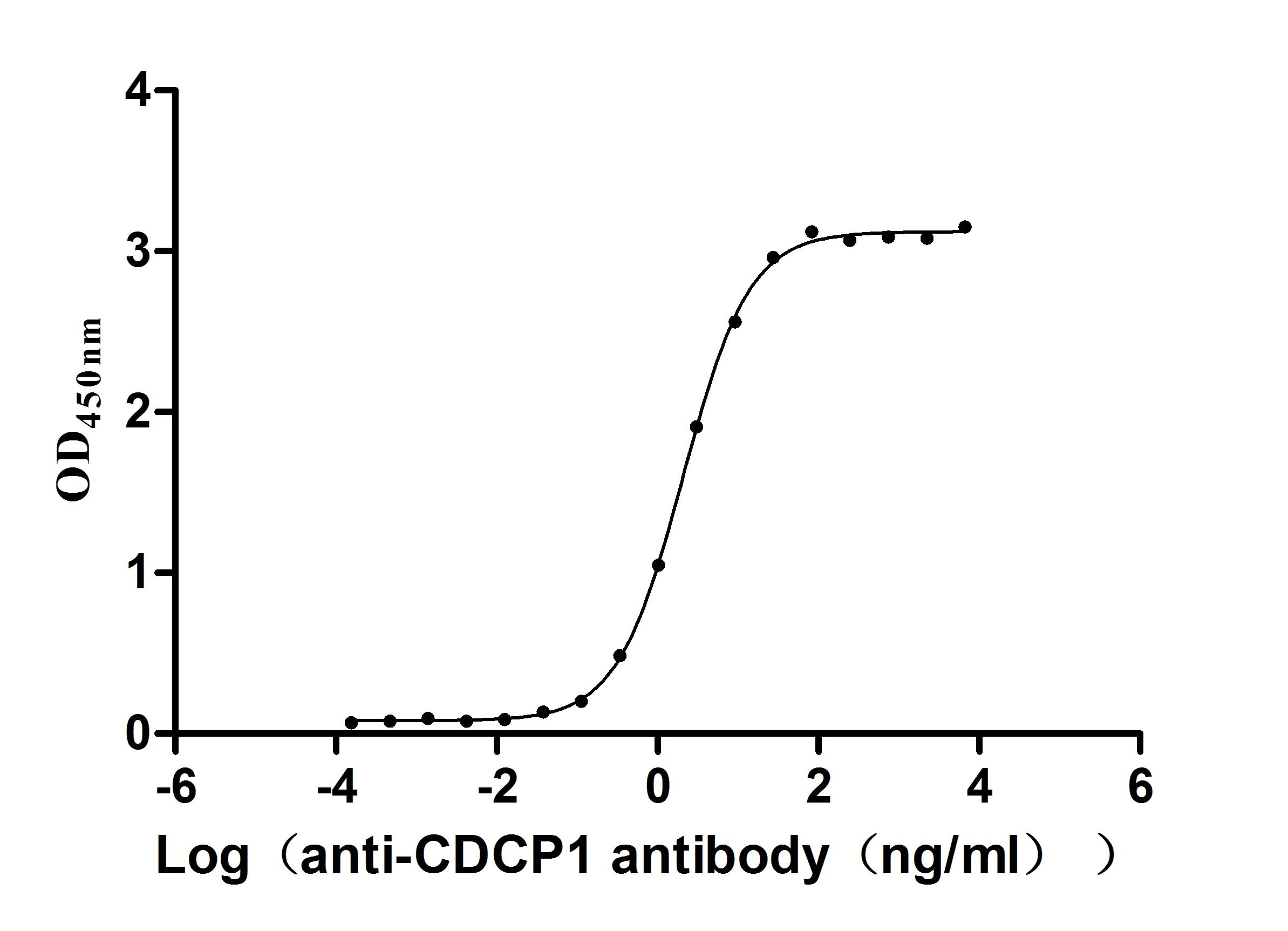Recombinant Rat Cannabinoid receptor 1 (CNR1)
In Stock Promotion-
中文名稱:
-
貨號:CSB-CF005678RA
-
規(guī)格:¥9720
-
促銷:
-
圖片:
-
其他:
產(chǎn)品詳情
-
純度:Greater than 90% as determined by SDS-PAGE.
-
基因名:
-
Uniprot No.:
-
種屬:Rattus norvegicus (Rat)
-
蛋白長度:Full Length
-
來源:in vitro E.coli expression system
-
分子量:58.9 kDa
-
表達區(qū)域:1-473aa
-
氨基酸序列MKSILDGLADTTFRTITTDLLYVGSNDIQYEDIKGDMASKLGYFPQKFPLTSFRGSPFQEKMTAGDNSPLVPAGDTTNITEFYNKSLSSFKENEENIQCGENFMDMECFMILNPSQQLAIAVLSLTLGTFTVLENLLVLCVILHSRSLRCRPSYHFIGSLAVADLLGSVIFVYSFVDFHVFHRKDSPNVFLFKLGGVTASFTASVGSLFLTAIDRYISIHRPLAYKRIVTRPKAVVAFCLMWTIAIVIAVLPLLGWNCKKLQSVCSDIFPLIDETYLMFWIGVTSVLLLFIVYAYMYILWKAHSHAVRMIQRGTQKSIIIHTSEDGKVQVTRPDQARMDIRLAKTLVLILVVLIICWGPLLAIMVYDVFGKMNKLIKTVFAFCSMLCLLNSTVNPIIYALRSKDLRHAFRSMFPSCEGTAQPLDNSMGDSDCLHKHANNTASMHRAAESCIKSTVKIAKVTMSVSTDTSAEAL
Note: The complete sequence including tag sequence, target protein sequence and linker sequence could be provided upon request. -
蛋白標(biāo)簽:N-terminal 10xHis-tagged
-
產(chǎn)品提供形式:Liquid or Lyophilized powder
Note: We will preferentially ship the format that we have in stock, however, if you have any special requirement for the format, please remark your requirement when placing the order, we will prepare according to your demand. -
緩沖液:If the delivery form is liquid, the default storage buffer is Tris/PBS-based buffer, 5%-50% glycerol.If the delivery form is lyophilized powder, the buffer before lyophilization is Tris/PBS-based buffer, 6% Trehalose.
-
復(fù)溶:We recommend that this vial be briefly centrifuged prior to opening to bring the contents to the bottom. Please reconstitute protein in deionized sterile water to a concentration of 0.1-1.0 mg/mL.We recommend to add 5-50% of glycerol (final concentration) and aliquot for long-term storage at -20℃/-80℃. Our default final concentration of glycerol is 50%. Customers could use it as reference.
-
儲存條件:Store at -20°C/-80°C upon receipt, aliquoting is necessary for mutiple use. Avoid repeated freeze-thaw cycles.
-
保質(zhì)期:The shelf life is related to many factors, storage state, buffer ingredients, storage temperature and the stability of the protein itself.
Generally, the shelf life of liquid form is 6 months at -20°C/-80°C. The shelf life of lyophilized form is 12 months at -20°C/-80°C. -
貨期:3-7 business days
-
注意事項:Repeated freezing and thawing is not recommended. Store working aliquots at 4°C for up to one week.
-
Datasheet & COA:Please contact us to get it.
相關(guān)產(chǎn)品
靶點詳情
-
功能:G-protein coupled receptor for cannabinoids, including endocannabinoids (eCBs), such as N-arachidonoylethanolamide (also called anandamide or AEA) and 2-arachidonoylglycerol (2-AG). Mediates many cannabinoid-induced effects, acting, among others, on food intake, memory loss, gastrointestinal motility, catalepsy, ambulatory activity, anxiety, chronic pain. Signaling typically involves reduction in cyclic AMP. In the hypothalamus, may have a dual effect on mitochondrial respiration depending upon the agonist dose and possibly upon the cell type. Increases respiration at low doses, while decreases respiration at high doses. At high doses, CNR1 signal transduction involves G-protein alpha-i protein activation and subsequent inhibition of mitochondrial soluble adenylate cyclase, decrease in cyclic AMP concentration, inhibition of protein kinase A (PKA)-dependent phosphorylation of specific subunits of the mitochondrial electron transport system, including NDUFS2. In the hypothalamus, inhibits leptin-induced reactive oxygen species (ROS) formation and mediates cannabinoid-induced increase in SREBF1 and FASN gene expression. In response to cannabinoids, drives the release of orexigenic beta-endorphin, but not that of melanocyte-stimulating hormone alpha/alpha-MSH, from hypothalamic POMC neurons, hence promoting food intake. In the hippocampus, regulates cellular respiration and energy production in response to cannabinoids. Involved in cannabinoid-dependent depolarization-induced suppression of inhibition (DSI), a process in which depolarization of CA1 postsynaptic pyramidal neurons mobilizes eCBs, which retrogradely activate presynaptic CB1 receptors, transiently decreasing GABAergic inhibitory neurotransmission. Also reduces excitatory synaptic transmission. In superior cervical ganglions and cerebral vascular smooth muscle cells, inhibits voltage-gated Ca(2+) channels in a constitutive, as well as agonist-dependent manner. Induces leptin production in adipocytes and reduces LRP2-mediated leptin clearance in the kidney, hence participating in hyperleptinemia. In adipose tissue, CNR1 signaling leads to increased expression of SREBF1, ACACA and FASN genes. In the liver, activation by endocannabinoids leads to increased de novo lipogenesis and reduced fatty acid catabolism, associated with increased expression of SREBF1/SREBP-1, GCK, ACACA, ACACB and FASN genes. May also affect de novo cholesterol synthesis and HDL-cholesteryl ether uptake. Peripherally modulates energy metabolism. In high carbohydrate diet-induced obesity, may decrease the expression of mitochondrial dihydrolipoyl dehydrogenase/DLD in striated muscles, as well as that of selected glucose/ pyruvate metabolic enzymes, hence affecting energy expenditure through mitochondrial metabolism. In response to cannabinoid anandamide, elicits a proinflammatory response in macrophages, which involves NLRP3 inflammasome activation and IL1B and IL18 secretion. In macrophages infiltrating pancreatic islets, this process may participate in the progression of type-2 diabetes and associated loss of pancreatic beta-cells.
-
基因功能參考文獻:
- he administration of FAAH inhibitor resulted in increased level of endocannabinoids in kidney of both groups of hypertensive rats led to enhanced expression of the cannabinoid receptors type 1 and 2 in SHR as well as vanilloid receptor 1 receptors in DOCA-salt rats. PMID: 29197803
- Results showed sensitivity of activated microglial cells to cannabinoids, increased CB1-CB2Het expression in activated microglia and in microglia from the hippocampus of an Alzheimer's model, and a correlation between levodopa-induced dyskinesia and striatal microglial activation in a Parkinson's disease model. PMID: 28843453
- A possible reduction in CB1R functionality, coupled with a hyperfunctional AT1R in the brainstem, could well be significant factors in the development of hypertensive states. AT1R-mediated phosphorylation of CB1R could be critical for impaired cerebellar development characterized by a hyperactive RAS PMID: 28887229
- observed selective alterations of DNA methylation at the promoter of CNR1, the gene coding for the type-1 cannabinoid receptor, in schizophrenic patients with no changes in bipolar or major depressive disorder. In an animal model prefrontal cortex found a significant increase in CNR1 expression and a consistent reduction in DNA methylation at specific CpG sites of gene promoter. PMID: 28108228
- Adolescent rats show an indiscriminate food seeking behavior, and a high motivation for food defining adolescent rats as impulsive. These traits are absent in adults and aged rats. CB1R and CB2R have an age-related expression, suggesting CB1R and CB2R may be considered part of the mechanisms that underlie motivated behavior. PMID: 27935269
- These findings identify a unique mechanism whereby bi-directional basolateral amygdala CB1R transmission can regulate opiate-related motivational processing and control affective states through functional modulation of mesolimbic neuronal activity. PMID: 27230434
- The results demonstrate that the neural coordination between the the gustatory and gastrointestinal insula is generated or suppressed by the opposing activities between CB1R and GPR119. PMID: 27581068
- results imply that endogenous cannabinoids may modulate the excitability and the output of Retinal Ganglion Cellss by differentially suppressing the activity of L- and T-type Calcium channels through activation of CB1Rs and CB2Rs. PMID: 28431968
- Data suggest maternal high-fat (HF) diet alters endocannabinoid system components and energy metabolism in hypothalamus and brown adipose tissue (BAT) of offspring at birth, in sex-specific manner; maternal HF diet up-regulates hypothalamic Cnr1 expression in male pups; maternal HF diet up-regulates hypothalamic Cnr2 expression in female pups; maternal HF diet down-regulates Cnr1 and up-regulates Cnr2 in BAT of all pups. PMID: 29102876
- Results suggest that, in male rats, endocannabinoids mediate immune challenge-inhibitory effects on reproductive axis at least partially via hypothalamic CB1 receptor activation. PMID: 28665507
- we have shown diurnal changes of cannabinoid receptor type 1 and type 2, which are of significant physiological and clinical interest. Considering the diurnal rhythm, the variation of CBR expression seems to be predominantly driven by food entrainment. Diurnal receptor changes are influenced by age. PMID: 28837063
- Study shows that the CB1R levels in dorsal hippocampus are increased by acquisition and reinstatement of morphine conditioned place preference. Intrahippocampal infusion of CB1R inverse agonists prevent morphine conditioned place preference reinstatement but not acquisition, suggesting that CB1R inverse agonist might be useful in the prevention of relapse to opiates. PMID: 28492416
- The presumably adverse experience of interacting with an unresponsive play partner appears to involve CB1R dependent mechanisms, since changes in play-soliciting behavior as well as the subsequent decrease in thermal pain sensitivity could be restored by acute administration of the CB1R antagonist/inverse agonist SR141716. PMID: 27157075
- The CB1 neutral antagonist AM4113 significantly attenuated nicotine taking, motivation for nicotine, as well as cue-, priming- and stress-induced reinstatement of nicotine-seeking behavior. PMID: 27493155
- Study analyzed the changes in the endogenous cannabinoid system (ECS) 12 months after experimental traumatic brain injury for the first time. The results showed that the expression of the CB1 receptor and 2-AG in the post-traumatic epilepsy (PTE) group was significantly higher than that in the non-PTE group, indicating that the ECS is involved in PTE pathology. PMID: 27810514
- Results showed that CB1R and SSTR5 colocalized in rat brain cortex, striatum, and hippocampus. CB1R was expressed in SSTR5 immunoprecipitate prepared from the brain tissue lysate, indicating their association in a system where these receptors are endogenously expressed. PMID: 27984180
- Results indicate that the early phases of excitotoxic spinal cord injury could not be arrested by pharmacologically exploiting the endocannabinoid system, consistent with the notion that CB1 agonist anandamide and its derivatives are more useful to treat late spinal cord injury phases. PMID: 27450568
- Data show a pivotal role for CB1 cannabinoid receptors, specifically those located in GABAergic cells, in the memory impairment and structural dendritic morphology alterations associated with the nicotine withdrawal syndrome. PMID: 27737762
- U46619 and ANG II may stimulate rapid endothelial release of endocannabinoids (mainly 2-arachidonoylglycerol), leading to CB1 receptor-dependent and/or CB1 receptor-independent vasorelaxation, which in the negative feedback mechanism reduces later agonist-induced vasoconstriction. PMID: 28356298
- demonstrate for the first time that Hippocampal CB1R transmission can potently modulate n. accumbens neuronal activity and can differentially control the formation of context-dependent and context-independent forms of rewarding or aversion-related emotional associative memories. PMID: 26681496
- Study concludes that exposure to post-training inescapable stress impaired memory consolidation. The impairing effects of stress on memory retrieval may be mediated by the ventral hippocampus cannabinoid CB1 receptors. PMID: 27282634
- Neuronal and smooth muscle CB1 and CB2 receptor expression and the nerve fiber density was diminished in the Obese Zucker Rat bladder. PMID: 27285468
- CB1 activation enhances protein synthesis via the mTOR pathway, resulting in long-term depression of inhibitory transmission in GABA-ergic presynaptic interneuron axons. PMID: 27764673
- Anandamide modulates the pro-aversive effects of intra-dorsomedial division of the ventromedial hypothalamus-bicuculline treatment, recruiting CB1 cannabinoid receptors and the TRPV1 channel is involved in the AM251-related potentiation of bicuculline effects on non-oriented escape behaviour. PMID: 27062913
- ZDF rats with global deletion of CB1R are protected from beta-cell loss, hyperglycemia, and nephropathy that are present in ZDF littermates. Adoptive transfer of CB1R(-/-) bone marrow to ZDF rats also prevents beta-cell loss and hyperglycemia but not nephropathy. PMID: 28082458
- Data suggest synthesis of endocannabinoids and expression of endocannabinoid receptors (Cnr1, Cnr2, and Trpv1) are altered in tissue-specific manner in obesity due to high-fat diet; chronic exercise reverses some of these alterations in skeletal muscle and subcutaneous/visceral adipose tissues. PMID: 26880264
- The bi-directional CB1 receptor-mediated cardiovascular effects of cannabinoids microinjected into the PVN of anaesthetized rats depend on stimulatory glutamatergic and inhibitory GABAergic inputs to the sympathetic tone. PMID: 27659492
- study showed the protective role of cannabinoid CB1 receptors in DOCA-salt small Mesenteric Arteries. PMID: 26969765
- Results support the possibility that dorsolateral periaqueductal gray cannabinoid type 1 and transient potential vanilloid type 1 receptors are involved in the expression of conditioned emotional response through the NMDA/NO/sGC pathway PMID: 26724373
- The results of this study suggest that decreased CB1 receptor expression is likely associated with the development of post-stroke depression. PMID: 26778127
- Data suggest that alterations of hippocampal cannabinoid type-1 receptors expression and function in food restricted rats are associated with dendritic spine remodeling and functional potentiation of CA1 excitatory synapses, and these findings are consistent with increasing evidence supporting the idea that food restriction may improve cognitive functions. PMID: 26354043
- Inhibition of the regulator of G protein signalling RGS4 in the spinal cord decreases neuropathic hyperalgesia and restores cannabinoid CB1 receptor signalling PMID: 26478461
- CB1 receptor mediated retrograde regulation provides a novel mechanism for modulating excitatory synaptic transmission in the inner retina. PMID: 25273281
- Curcumin and hemopressin treatment attenuates cholestasis-induced liver fibrosis in rats: role of CB1 receptors PMID: 26475620
- Data suggest a strong interaction between 5-HT4 and CB1 receptors within the nucleus accumbens shell PMID: 26340366
- Results imply that activation of TRH receptors in these midline thalamic neurons engages novel signaling pathways that include postsynaptic intracellular CB1 and CB2 receptors in the activation of TRPC4/5-like channels PMID: 26470810
- CB1Rs modulate the hydroelectrolytic balance independently of the food intake during sustained hyperosmolality and hypovolemia. PMID: 26497248
- Results suggest that Cnr1 and the cannabinoid system of the retrosplenial cortex modulate emotional memory PMID: 26572648
- Co-injection of Cnr1/2 antagonists with morphine attenuated expression of tolerance to morphine analgesic effects and decreased the morphine analgesia. PMID: 25894754
- The main findings of the experiments are, first, that antagonism of CB1 receptors increased anxiety-like and fear behavior in female rats. Second, a modest anxiolytic effect of CB1 receptor agonism was observed in the open field test. PMID: 26311003
- Study suggested that somatostatin and nNOS are expressed in most interneurons whereas CB1 receptor is present in both interneurons and projection neurons in hippocampal regions PMID: 26115586
- Results suggest that orexin-A/OX1R dependent activation of the RVLM nNOS/ERK1/2 cascade is essential neurochemical mechanism for the central CB1R-mediated pressor response in conscious rats PMID: 26096126
- Genetic and pharmacological study indicates that CB1R are not necessary for adaptation of the HPA axis and other variables to repeated exposure to stress either in mice or rats PMID: 26092203
- CB1Rs participate in the homeostatic responses regulating fluid balance and energy homeostasis during water deprivation. PMID: 26468265
- interactive role of cannabinoid and vanilloid systems in hippocampal synaptic plasticity PMID: 25843413
- This animal model show that the activity state of the CB1R is an important molecular mediator of adolescent behavior. PMID: 26468198
- Study showed an overlapping distribution of CB1 and OX1 in status epilepticus hippocampus; increased hippocampal expression of CB1 indicates that CB1 may play an important role in the underlying disease mechanism, but the effect of OX1 was not obvious PMID: 25446454
- During liver regeneration signaling mediated by anandamide through CB1 receptor may be important for the entry and progression of cells into the cell cycle and hence for their proliferation under mitogenic signals. PMID: 25684344
- Vasoconstriction and hypertension is modulated by endocannabinoid-induced Galphaq11-CB1 cannabinoid receptor signaling. PMID: 25595485
- The studies reveal how CB1 receptor activation translates into beta-arrestin signaling and identify a mechanism to control this pathway. PMID: 25081814
顯示更多
收起更多
-
亞細胞定位:Cell membrane; Multi-pass membrane protein. Mitochondrion outer membrane. Cell projection, axon. Cell junction, synapse, presynapse.
-
蛋白家族:G-protein coupled receptor 1 family
-
組織特異性:Expressed in the brain, in the striatum, medial septum, descending arm of the band of Broca, the amygdaloid nucleus, the hippocampus and cortex (at protein level). High levels in the lateral striatum. In rostral brain regions, high expression levels in th
-
數(shù)據(jù)庫鏈接:
Most popular with customers
-
Recombinant Human Neuropilin-1 (NRP1) (Active)
Express system: Mammalian cell
Species: Homo sapiens (Human)
-
Recombinant Human V-set and immunoglobulin domain-containing protein 4 (VSIG4), partial (Active)
Express system: Mammalian cell
Species: Homo sapiens (Human)
-
Recombinant Macaca fascicularis Membrane spanning 4-domains A1 (MS4A1)-VLPs (Active)
Express system: Mammalian cell
Species: Macaca fascicularis (Crab-eating macaque) (Cynomolgus monkey)
-
Recombinant Human Oncostatin-M (OSM), partial (Active)
Express system: Mammalian cell
Species: Homo sapiens (Human)
-
Recombinant Human CD81 antigen (CD81), partial (Active)
Express system: Mammalian cell
Species: Homo sapiens (Human)
-
Recombinant Macaca fascicularis CUB domain containing protein 1 (CDCP1), partial (Active)
Express system: Mammalian cell
Species: Macaca fascicularis (Crab-eating macaque) (Cynomolgus monkey)
-
Recombinant Macaca fascicularis Zinc transporter ZIP6 isoform X1(SLC39A6),partial (Active)
Express system: Baculovirus
Species: Macaca fascicularis (Crab-eating macaque) (Cynomolgus monkey)





















